I’ve put myself into a strange schedule for Lent. I’ve decided to, “say mass” (or as we typically describe it in Anglicanism “celebrate Holy Communion”) every day during Lent.
We have 46 days in Lent – six of them are Sundays where we have normally have our weekly communion service. Monday through Saturday in Lent 2021, I’ll be offering a daily 7 AM Holy Communion service.
Today was my first one. I got up and set up the church in a dark silence. My first task was trying to remember where the sacristans keep all of our communion supplies and altar linens. Then I set up a tripod to livestream the service.
Anglican theology and the prayerbook itself expects that the priest is celebrating with a congregation. It is very normal for me to saying the offices (Morning Prayer/Evening Prayer) by myself, but Holy Communion is rightly done with at least one other person present. It fits the character of what is being done at the altar and also guards against many superstitions. Since this is new and early, I didn’t expect to have visitors and therefore commissioned some of my family to join me. By having my wife or children come into the service, I wouldn’t be celebrating alone.
So how does one celebrate daily?
One question might be, “should we?” The frequent celebration of Holy Communion might be associated with Roman Catholic practices in the minds of some people, but the frequent public celebration of communion was a protestant “win” for Christendom. While it is true that medieval monks did have frequent private masses in side chapels for various superstitious reasons, the idea of a daily mass for the laity was unheard of during the period preceding the Reformation.
Many of my Evangelical and Reformed friends are often shocked to find out that the Medieval church only expected the pious to come to communion a few times a year. And that receiving communion (in one kind) was so feared (or perhaps revered) that their idea of reception was frequently ocular or “gazing up” at the elements during the consecration. This is also the reason why many churches rang bells at this moment as a sort of “don’t miss it” signal.
The English Reformation was therefore a dramatic shift for the laity. The expectation of weekly services plus various festivals also meant that men, women, and some children would be brought to the Lord’s Supper each time. This matched the theology of continental reformers like John Calvin who argued for at least weekly celebrations of communion. (see Inst. IV. XVII. 46) Again, this too is often a surprise to many calvinists in Presbyterian and Reformed churches that now limit communion to monthly or quarterly celebrations. Ironically, many have unknowingly reverted to the medieval position.
Is Daily Mass required?
“Daily Mass” is nowhere required for a church–although it could be argued that it may be appropriate for a cathedral or larger church. There is of course a Biblical precedent for daily communion in the Book of Acts. We read of the daily “breaking of bread” in Acts 2:42-46. At this time, the church still combined its house church-based preaching and liturgical prayers with its agape feast. The early Christian writings suggest that worship on the Day of the Resurrection (our Sunday) became the standard “day of obligation.” This means that weekly worship became a minimum and those who failed to show up had to publicly repent. This should not preclude more frequent services which would be likely in Apostolic Christianity as a missionary church with traveling ministers.
There is also the question of how to celebrate.
If we look through the propers (the weekly readings) for Holy Communion in the standard American Book of Common Prayer (1928), we will notice that the prayerbook only provides communion propers on a weekly basis and few holy days.
There are a few approaches to fill in the days not listed in the standard prayerbook. One option is to simply repeat the propers from Sunday. Some prefer this as a way of being faithful to the prayerbook. Although in the 1960’s the Episcopal Church produced a book called, “Lesser Feasts and Fasts.” This book contains the collects and readings for celebrating communion on more days. It has specific seasonal days like, “Friday After Ash Wednesday” and a longer list of saints and venerable Christians. It also contains “commons” for saints that may not be listed and other special occasions like “for the mission of the church.” These themed readings can be dropped into ferials or days that may not have ordinary propers. (I’ve uploaded a PDF here.) There are also various propers outlined in the Missal – I have a version of the American Missal from Lancelot Andrewes Press that can provide propers from the 1952 Missal. Although this book contains some counter-reformation days and has to be read/used carefully. Between these, one can fill in the days and enjoy seasonal and themed celebrations of Holy Communion throughout Lent and any portion of the church year.
Note on the word Mass: The word “mass” is sometimes off putting to protestants who associate it with the Roman Catholic Church. The word “Mass” comes from the Latin word, ” Missa.” Historically, the people were dismissed at the end of Communion with the words “Ite, missa est.”

Leave a ReplyCancel reply